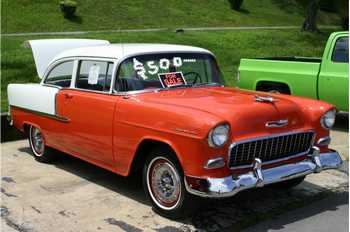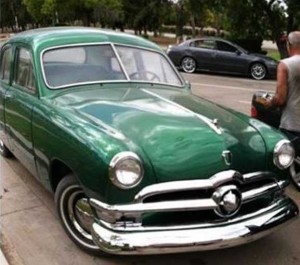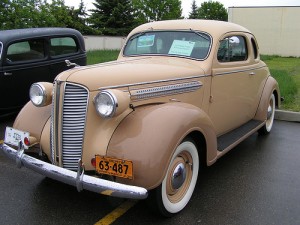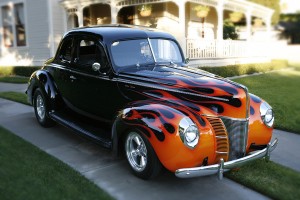by Jack
 For those of us old enough to remember, there was a time when a guy with a few tools and a Chilton’s manual, could fix most things on a car.
For those of us old enough to remember, there was a time when a guy with a few tools and a Chilton’s manual, could fix most things on a car.
This was a simpler time, long before things got complicated with SMOG equipment, a plethora of power accessories, on-board computers, etc.. This was long before hybrids, automatic transmissions and adjustable air-ride suspensions, and many other ”luxury” things we take for granted today.
Back in this day, a hybrid might be considered a 40 Ford with a Corvette engine. (A nice combination I might ad.) In the late 1950’s a Toyota Prius rolling into the local A & W drive-in would have garnered a lot of attention, but likely not in a good way….oh, we’ve come a long way since then haven’t we? lol
The cars made in Detroit before 1950 were incredibly basic compared to today’s vehicles, which I admit are more reliable, but in the process of employing computers and high tech we also lost something too. Simplicity of those old style cars was their beauty, if not their affordability. And we needed something cheap back then because teens in my day (60’s) typically had to find something under $500 for a starter car.
In 1963 $500 would actually buy a reasonable “transportation” car. But, more often than not, the customizing of that car began and things got a wee bit more expensive. This meant having a part  time job to support your car hobby. Knowledge comes with a price! And that was good hobby too, even if we devoted too much money to it. Because kids were motivated to (1) get a job and work for money and (2) show off their creativity. Your car was often times a visible example of your hard work and mechanical skill that went into its customizing.
time job to support your car hobby. Knowledge comes with a price! And that was good hobby too, even if we devoted too much money to it. Because kids were motivated to (1) get a job and work for money and (2) show off their creativity. Your car was often times a visible example of your hard work and mechanical skill that went into its customizing.
Owning something you virtually built was fun! And for us guys, well, it could be a ”babe” magnet, many true loves began because of a car. Yep, cars were fun back then and life was too, because things were just simpler. We had a sense of being in control of things, but not so much anymore.
I was just 16 when I bought my first car, a 1937 Dodge Coupe (see right) with a flat head 6. It looked cool, but my bicycle was faster for the first 100 feet. Of course cars made in the 30’s had no air conditioning, that was for late 40’s early 50’s luxury cars. But, what the 37 had was a crank on the center of the dash so you could open the windshield from the bottom out, about 6 inches. This worked well enough to cool you off. That rush of cool air coming across the hood and slipping under open windshield was great, except for the occasional time when a bee or wasp slipped in too.
The old Dodge was so smooth at idle you often couldn’t tell if it was running, not unusual for a flathead. Then gain, they didn’t have much power either.
I paid $50 for my first ride and had a friend put a metallic blue paint job on it for another $50. For $100 car it looked pretty sharp and grabbed a lot of looks. I can’t emphasize this enough, there was a lot of pride that went into fixing up old cars and almost any car would do. It didn’t really matter much, as long as they were American made. Okay, let me qualify that, it has to have some redeeming qualities and we pretty much drew the line at those Ramblers and little tooter-cars from Europe.
Like the average high school kid, to say that I loved cars was probably a great understatement. Everything seemed to revolve around who was driving what and who had the fastest quarter miler, especially while we were in high school.
By the time I left high school I think I had bought and sold 18 cars and I racked up about 16 traffic tickets or was that 16 cars and 18 tickets, I forget? I was a car nut and determined to buy and sell my way up to really great hot rod. I should mention most of the cars I bought and sold were less than $700 and I probably made $200 on the sale if I was lucky.
Somehow I survived those days of fast cars and now I am left with a lot of fond memories.
It’s too bad that kids today have settle for an iPad or a Nintendo game player. To do a mere diagnostic on a vehicle you need a computer scanning tool, if not more. Shops are required to invest in a $100k computer to do their diagnosing. But, given the complexity of todays cars this is the new reality. It’s no wonder shops are charging $100 an hour! I have to admit that computer designed parts are made with more precession and therefore they have more reliability, so modern cars don’t need the same mechanical repair those old cars once did, but when they do it’s never cheap.
 Kids don’t have the same easy opportunity to learn about amazing mechanical things like I did. My former hobby of tinkering on cars inspired a lot of entrepreneurs to do many great things later in life. But, other than these fancy 26 inch wagon wheels, there’s not much the average kid can afford to do to his modern ride. Engine modifications are almost out of the question thanks to SMOG regulations and the sheer cost of trying to work on something controlled by a computer chip. So, a whole area of learning and experimenting has been placed beyond the reach of many future generation. Seems a shame and I wish we could turn the clock back to salvage what was worth keeping in Detroit iron.
Kids don’t have the same easy opportunity to learn about amazing mechanical things like I did. My former hobby of tinkering on cars inspired a lot of entrepreneurs to do many great things later in life. But, other than these fancy 26 inch wagon wheels, there’s not much the average kid can afford to do to his modern ride. Engine modifications are almost out of the question thanks to SMOG regulations and the sheer cost of trying to work on something controlled by a computer chip. So, a whole area of learning and experimenting has been placed beyond the reach of many future generation. Seems a shame and I wish we could turn the clock back to salvage what was worth keeping in Detroit iron.
Suppose Detroit built a good looking American car, one that is affordable on a modest budget and it’s simple to maintain. This would be a car that you change the spark clubs and not pull the engine out to do it. It would be nibble and quick and it would get about 30 mpg, because it is not laden down with 1200 lbs. of extra steel parts, mostly useless, mandated by the government. Don’t you think a car like this would sell like hotcakes? Government bureaucracy is the only thing that stands in the way.

Of course the cars needed a lot more service and repairs back then. Remember filling points, adjusting the timing, replacing spark plugs, you know what use to be called a “tune up. Cars don’t need any of that kind of stuff any more. On my Toyota Matrix, the plugs are rated for 125K miles!
Jim, most models that came with those old breaker point distributors could be upgraded to a solid state ignition for about $50. Once that was done you never had to mess with points again. Points were a pain. The spark was better with the electronic ignition and the plugs lasted longer, but I never made plugs last anywhere near 125k miles. The most I’ve asked of a set of inexpensive spark plug to run was about 60,000 miles. That’s more than enough to suit me, even though they might have one another 40k. I like change them out early, as I found it doesn’t really pay to try to squeeze the last little bit of performance out mechanical things. Call it peace of mind.